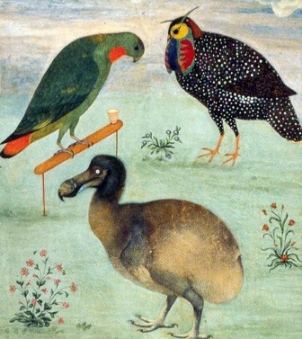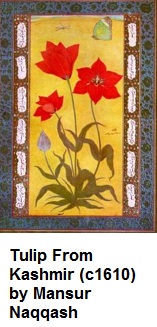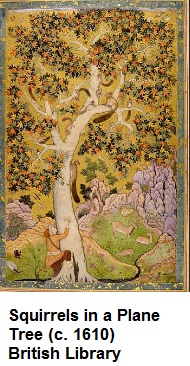Hassan and Ustad Mansur












Hassan and Ustad Mansur
Hassan and Ustad Mansur: Jahangir considered Mansur and Abu'l Hasan to be exceptional artists Abu'l Hasan was given the titled of Nadir uz Zaman Several 17th-19th century artists​.
USTAD MANSUR
Ustad Mansur (flourished 1590-1624) was a seventeenth-century Mughal painter and court artist. He grew up during the reign of Jahangir (r. 1605 - 1627) during which period he excelled at depicting plants and animals. He was the earliest artist to depict the dodo in colour, apart from being the first to illustrate the Siberian crane. Towards the end of Akbar's reign, he gained the title of ustad (master) and during the reign of Mughal emperor Jahangir his masterpieces earned him the title of Nãdir-al-’Asr ("Unequalled of the age"). Although largely known for his natural history illustrations, he also portrayed people in various manuscript illustrations.
LIFE AND WORK MANSUR
1 The year of Mansur's birth is unknown. His name was suffixed in some early miniatures as Naqqash, which can refer to an artist, painter, or carver, indicating that he came from a family that was in an artistic profession.
2 Mansur painted at least one hundred flowers from the Kashmir valley during this period. A red tulip from Kashmir is a better-known painting. The identity of the tulip is however debated with competing suggestions that include Tulipa Lanata.

3 Mansur's birds were based on reality. He also created fantasy birds and many of the compositions such as the flowers and insects in the background are juxtapositions created for effect. The most significant paintings, in terms of zoology, are those of the Siberian crane and the dodo. The Siberian crane painting was made well before it was formally described and given a binomial name by Peter Simon Pallas in 1773.

Shah Jahan’s reign saw the art of painting reach its zenith. Portrait paintings become life-like and graceful during his time. Distinct styles of miniature painting, like the Kangra, the Rajasthani and the Deccani, developed. The main theme of the paintings of the Kangra and the Rajasthani schools was devotional. Several paintings illustrate stories about Radha and Krishna, and Krishna and the gopis. The Deccani paintings focused more or court scenes and scenes of battle. During Shah Jahan’s time, gold was also used in paintings. The Rajputs seem to have preferred the miniature style of painting. They also painted the walls of their palaces and havelis.
ABU AL HASSAN
Abu al-Hassan was the son of Aqa Reza of Herat in western Afghanistan a city with an artistic tradition. Aga Reza had taken up employment with Jahangir before the latter's accession to the throne of the Mughal empire.
Abu al-Hasan was initially trained by the emperor himself in his large studios and workshops but soon surpassed his father and his employer. Jahangir said of him that he had no equal and bestowed the title Nadir-uz-Saman ("Wonder of the Age") on him.
His works
Abu al-Hasan's main task was the documentation of events at the imperial court, which resulted in many superb portraits. Not many of Abu al-Hasan's paintings survived, but those that identify him as the artist show that he also worked on a range of subjects including some everyday scenes.
The most famous painting associated with his name, Squirrels in a Plane Tree, is a masterful depiction of animal posture and movement that could only have been derived from direct observation. Since the painting depicts European squirrels unknown in India his work suggests that Jahangir's zoo may have held a few of these animals.

Alternatively Abu al-Hasan may have accompanied Jahangir on one of his travels. The signature on the painting is confusing; Nadir al-Asr ("Miracle of the Age") is the title of Ustad Mansur , not of Abu al-Hasan, but the painting is definitely not Ustad Mansur's style. It is possible that both painters collaborated on this painting.
Students / Parents Reviews [20]
Abhyas Methodology is very good. It is based on according to student and each child manages accordingly to its properly. Methodology has improved the abilities of students to shine them in future.

Manish Kumar
10thAbhyas academy is great place to learn. I have learnt a lot here they have finished my fear of not answering.It has created a habit of self studying in me.The teachers here are very supportive and helpful. Earlier my maths and science was good but now it has been much better than before.

Barkha Arora
10thIt was good as the experience because as we had come here we had been improved in a such envirnment created here.Extra is taught which is beneficial for future.

Eshan Arora
8thMy experience with Abhyas academy is very good. I did not think that my every subject coming here will be so strong. The main thing is that the online tests had made me learn here more things.

Hiya Gupta
8thAbhyas institute is one of the best coaching institute in the vicinity of Ambala cantt.The institute provides good and quality education to the students.The teachers are well experienced and are very helpful in solving the problems. The major advantages of the institute is extra classes for weak...

Shreya Shrivastava
8thMy experience with Abhyas Academy has been very good. When I was not in Abhyas whenever teacher ask questions I could not speak it confidently but when I came in Abhyas, my speaking skills developed and now I am the first one to give the answer of teachers question.

Upmanyu Sharma
7thMy experience with Abhyas is very good. I have learnt many things here like vedic maths and reasoning also. Teachers here first take our doubts and then there are assignments to verify our weak points.

Shivam Rana
7thMy experience with Abhyas academy is very nice or it can be said wonderful. I have been studying here from seven class. I have been completing my journey of three years. I am tinking that I should join Abhyas Academy in tenth class as I am seeing much improvement in Maths and English

Hridey Preet
9thThird consective year,my ward is in Abhyas with nice experience of admin and transport support.Educational standard of the institute recumbent at satisfactory level. One thing would live to bring in notice that last year study books was distributed after half of the session was over,though study ...

Ayan Ghosh
8thUsually we see institutes offering objective based learning which usually causes a lag behind in subjective examinations which is the pattern followed by schools. I think it is really a work of planning to make us students grab the advantages of modes of examination, Objective Subjective and Onli...

Anika Saxena
8thAbhyas institute is one of the best coaching institute in the vicinity of Ambala Cantt area. The teachers of the institute are well experienced and very helpful in solving the problems of the students.The good thing of the institute is that it is providing extra classes for the students who are w...

Aman Kumar Shrivastava
10thOne of the best institutes to develope a child interest in studies.Provides SST and English knowledge also unlike other institutes. Teachers are co operative and friendly online tests andPPT develope practical knowledge also.

Aman Kumar Shrivastava
10thI have spent a wonderful time in Abhyas academy. It has made my reasoning more apt, English more stronger and Maths an interesting subject for me. It has given me a habbit of self studying

Yatharthi Sharma
10thMy experience was very good with Abhyas academy. I am studying here from 6th class and I am satisfied by its results in my life. I improved a lot here ahead of school syllabus.

Ayan Ghosh
8thAbhyas is a complete education Institute. Here extreme care is taken by teacher with the help of regular exam. Extra classes also conducted by the institute, if the student is weak.

Om Umang
10thIt was a good experience with Abhyas Academy. I even faced problems in starting but slowly and steadily overcomed. Especially reasoning classes helped me a lot.

Cheshta
10thAbhyas is an institute of high repute. Yogansh has taken admission last year. It creates abilities in child to prepare for competitive exams. Students are motivated by living prizes on basis of performance in Abhyas exams. He is satisfied with institute.

Yogansh Nyasi
7thAbout Abhyas metholodology the teachers are very nice and hardworking toward students.The Centre Head Mrs Anu Sethi is also a brilliant teacher.Abhyas has taught me how to overcome problems and has always taken my doubts and suppoeted me.

Shreya Shrivastava
8thBeing a parent, I saw my daughter improvement in her studies by seeing a good result in all day to day compititive exam TMO, NSO, IEO etc and as well as studies. I have got a fruitful result from my daughter.

Prisha Gupta
8thThe experience was nice. I studied here for three years and saw a tremendous change in myself. I started liking subjects like English and SST which earlier I ran from. Extra knowledge gave me confidence to overcome competitive exams. One of the best institutes for secondary education.
